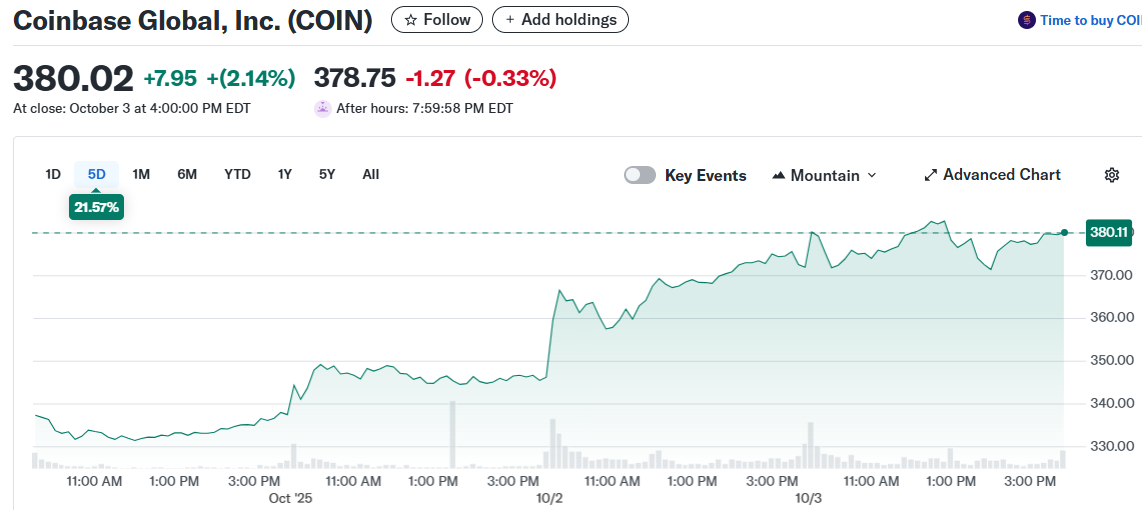TLDR
- Coinbase stock rose 2.59% to $381.80 after Rothschild & Co. upgraded it to “Buy” with a $417 price target
- Rothschild says Coinbase is diversifying away from retail trading fees, which will drop from 90% to 50% of revenue by next year
- The company is growing institutional trading, derivatives, subscription services, USDC income, and its Base Layer-2 network
- Coinbase announced a partnership with Samsung to integrate its services into 75 million Galaxy devices in the U.S.
- The Samsung Wallet integration puts crypto trading and payment tools alongside everyday features like transit passes and digital keys
Coinbase Global, Inc. (COIN) shares increased 2.59% to $381.80 on October 3. The gains followed two major developments for the cryptocurrency exchange.

Rothschild & Co. upgraded Coinbase stock to “Buy” with a $417 price target. At the same time, Coinbase announced a partnership with Samsung to integrate its services into Galaxy devices.
Rothschild Sees Business Model Shift
Rothschild’s upgrade focuses on Coinbase’s changing revenue structure. The investment bank believes the market still values Coinbase based mainly on Bitcoin’s price movements.
Coinbase gets an upgrade from Rothschild on growing crypto adoption in finance https://t.co/AFOwheVjnl
— CNBC (@CNBC) October 3, 2025
However, Coinbase’s business has evolved beyond its original model. Retail transaction fees once made up about 90% of the company’s revenue. Rothschild projects this figure will drop to nearly 50% next year.
The shift comes from growth in other areas. Institutional trading is expanding faster than retail. Coinbase is also generating more income from derivatives trading.
The company earns revenue from subscription and services offerings. This includes money from USDC, the stablecoin it partners on with Circle. Coinbase also operates Base, a Layer-2 blockchain network that generates fees.
Rothschild acknowledges that trading fees across the industry are getting compressed. But the bank argues that higher trading volumes and deeper institutional adoption will make up for lower fee rates.
The investment bank took a different view on Coinbase’s competitors. Rothschild gave Circle a neutral rating despite USDC’s $73 billion supply. The bank noted Circle pays over 60% of its reserve interest income to distribution partners like Coinbase.
Rothschild maintained a sell rating on Robinhood. The bank said Robinhood’s crypto business remains too dependent on retail traders and vulnerable to fee pressure.
Samsung Integration Reaches 75 Million Devices
The Samsung partnership represents a major distribution channel for Coinbase. The deal integrates Coinbase services into Samsung Pay on 75 million Galaxy devices in the United States.
Users will be able to access crypto trading and payment features directly from Samsung’s native wallet. Coinbase services will sit alongside existing Samsung Pay functions like transit passes and digital keys.
The integration brings cryptocurrency tools to mainstream Samsung users. It represents one of the largest consumer distribution deals in Coinbase’s history.
The partnership executes on Coinbase’s strategy to diversify its business. By embedding crypto services into everyday mobile tools, Coinbase gains access to users who might not have otherwise used its platform.
The Samsung deal also normalizes digital asset usage for a mass-market audience. Users can now manage crypto alongside traditional payment methods in a familiar interface.
Coinbase’s stock performance on October 3 reflected investor response to both announcements. The Rothschild upgrade validated the company’s business evolution while the Samsung deal demonstrated execution on growth strategy.






